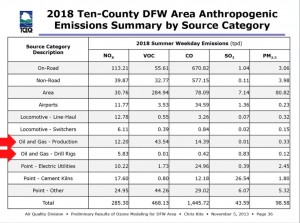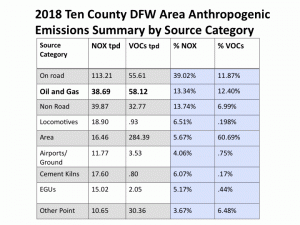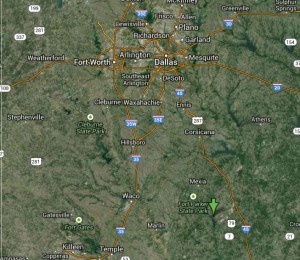TCEQ
Highlights from Monday: How the State Hides Gas Industry Pollution
 Want to see one example of how low state bureaucrats will stoop to underplay the significance of the impact of oil and gas pollution on DFW air quality? Take a look at some slides that were part of Monday's presentation by Downwinders at Risk's Jim Schermbeck to the regional air planning meeting.
Want to see one example of how low state bureaucrats will stoop to underplay the significance of the impact of oil and gas pollution on DFW air quality? Take a look at some slides that were part of Monday's presentation by Downwinders at Risk's Jim Schermbeck to the regional air planning meeting.
In the first you'll see how the state officially ranks all the "source categories" for human-made, or "Antrhopogenic," smog-forming Nitrogen Oxides (NOx) and Volatile Organic Compounds (VOCs) pollution in North Texas (all the numbers are Tons Per Day):
Yes the pic is fuzzy, (we can land a person on the Moon but can't seem to get charts to show up with a jpeg format online) but if you squint really hard, you'll notice there are two categories for Oil and Gas pollution numbers among the more traditional "Point Sources," Off-Road, "On-Road", etc – "Oil and Gas Production" and "Oil and Gas – Drill Rigs." Looking at these two categories you might think that adding them together would produce total Oil and Gas pollution numbers. You'd be wrong.
As it turns out, there are other Oil and Gas pollution numbers hidden away in other categories in this chart not labeled "Oil and Gas." For example, in both the "Area" and "Point-Other" categories are the numbers for NOx and VOCs pollution from gas compressors. But wait, you object, aren't gas compressors an integral part of any kind of "Oil and Gas Production?" Yes, yes they are. So why aren't they included in that category instead of being stuffed anonymously in these other categories? Great question. Perhaps it has something to do with the volume of pollution they release. Because when you finally wrestle the numbers from the Texas Commission on Environmental Quality (the TCEQ didn't voluntarily offer this information), compressor pollution turns out to double the amount of smog-forming NOx released from the Oil and Gas industry in the DFW 10-county "non-attainment area." And NOx pollution is what the TCEQ keeps saying is driving our chronic smog problem. Here's the way Schermbeck presented the same TCEQ "source categories" with the compressor numbers now teased out and added to the ones already identified as Oil and Gas: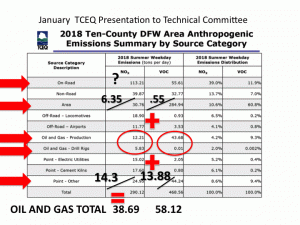
These additions raise the industry's polluter profile significantly. And that's what this next slide is doing. It's totaling all the Oil and Gas pollution and then re-ranking the categories based on these new numbers. Same totals, just different, and more honest, organization of the individual source figures. Instead of Oil and Gas emissions looking relatively small in relation to other sources like cement kilns and power plants and even locomotives, it escalates the Oil and Gas industry into one of the region's foremost industrial air polluters:
And even this much larger number is still underplaying the total amount of air pollution fracking adds to regional air quality because the state hasn't bothered to try to tease-out the "on-road" pollution that all those fracking waste and water trucks adds to the mix. State air modelers shrugged their shoulders and said they couldn't figure out how on earth to do that. Just by "Googling" the subject, Schermbeck found at least two previous studies that did that very thing – a 2005 Denton report and a 2013 Rand Corporation report that even estimated the amount of dust pollution raised by those trucks.
While those truck totals remain a mystery for now, using the TCEQ's own numbers, compressors make up at least 53% of the total NOx pollution released by the Oil and Gas industry in North Texas, and a full quarter of all VOC pollution released. According to Schermbeck, that's why they make such good targets for electrification, an air pollution control measure he was recommending as part of his larger presentation to the regional air planning committee on Monday.
This is just one example of the kind of duplicitous behavior the state of Texas is resorting to in trying to hide the true environmental and public health impact of the Oil and Gas industry. No slight of hand is too petty. Only by diligent digging by citizens is the truth coming out, ton by ton.
Schembeck's entire (unfuzzy) presentation is now online at the North Central Texas Council of Governments website as part of the June 16th agenda. It loses something without his accompanying narration but the jest of it is easily discerned for those who want to plod through it: TCEQ is doing anything but a sincere job of building a serious clean air plan for DFW. But then again, we bet you already knew that.
Rick Perry, with a Smoking Gun, in the COG Headquarters: Monday at 10 am
 The latest chapter in a decades old mystery game of "Get a Clue" happens tomorrow morning, Monday, June 16th when representatives of the Sierra Club and Downwinders at Risk present their case against the current state anti-smog plan during the regional air planning meeting at the headquarters of the North Texas Council of Governments, 616 Six Flags Road in Arlington. Come find out who and/or what keeps the DFW area from ever meeting federal clean air standards year after year and what can be done about it. The meeting starts at 10 am. Citizen groups are expected to do their presentations in the 11 to 12 hour. Then we'll all have a debriefing lunch at the Subway's down the street hosted by State Representative Lon Burnam. Y'all come.
The latest chapter in a decades old mystery game of "Get a Clue" happens tomorrow morning, Monday, June 16th when representatives of the Sierra Club and Downwinders at Risk present their case against the current state anti-smog plan during the regional air planning meeting at the headquarters of the North Texas Council of Governments, 616 Six Flags Road in Arlington. Come find out who and/or what keeps the DFW area from ever meeting federal clean air standards year after year and what can be done about it. The meeting starts at 10 am. Citizen groups are expected to do their presentations in the 11 to 12 hour. Then we'll all have a debriefing lunch at the Subway's down the street hosted by State Representative Lon Burnam. Y'all come.
Thank You. Citizens Might Have Just Saved The Local Air Planning Process…From Itself
 A year from now, last Thursday' meeting in Arlington may be seen as a turning point.
A year from now, last Thursday' meeting in Arlington may be seen as a turning point.
Local residents refused to let the air quality planning process die, showing up in numbers that forced officials to switch to a larger room, and making sure their opposition to another state "do-nothing" air plan was heard loud and clear.
Their participation had already changed the day's agenda. Included was a breakthrough UNT study that directly challenges the Texas Commission on Environmental Quality's claim that natural gas emissions don't increase DFW smog.
UNT's Dr. Kuruvilla John's presentation of the new study received quite a bit of media coverage, before, during, and after Thursday's meeting. You can find some of the best coverage by clicking on the links below.
UT-Austin Study Reveals "Underestimates"
Dr. John's presentation influenced another researcher's slide show as well. Scheduled to speak about older, more generic ambient air measurements for ozone, Dr. David Allen of UT Austin instead presented more recent research into gas pollution as well.
Overlooked in the debut of the UNT study, Allen's constant monitoring of one drill site in Fort Worth revealed that the TCEQ was underestimating emissions from the pneumatic valves at the site by 159%.
That was news to both citizens and TCEQ, who said they hadn't looked at Allen's research and hadn't corrected their inventories to account for such underestimates. Valves like these are powered by natural gas, are quite numerous on gas equipment, and account for a large percentage of VOCs released from a fracking site.
A Better Picture of Oil and Gas Pollution
Citizen cross-examination of TCEQ staff members present at the meeting also revealed a different look at the volume of Oil and Gas industry pollution in the 10-county DFW "non-attainment area"
Up to Thursday, TCEQ was dispersing Oil and Gas pollution across several categories, making it impossible to show the true total impacts.
Here's an example of the way TCEQ likes to present the info:
SOURCES OF SMOG-FORMING NITROGEN OXIDE POLLUTION (NOx)
IN DFW's NON-ATTAINMENT AREA
1. "On Road" vehicles 113.21 tons per day
2. "Non-Road" vehicles" 39.87 tpd
3. "Area" 30.76 tpd
4. "Other Point Sources" 24.95 tpd
5. "Locomotives" 18.90 tpd
6. "Cement Kilns" 17.60 tpd
7. "Electric Utilities" 15.02 tpd
8. Oil and Gas Production 12.21 tpd
9."Airports" 11.77 tpd
10. Oil and Gas Drill Rigs 5.83 tpd
TOTAL 290.12 tpd
This makes it look like Oil and Gas pollution is not that big a deal.
But it turns out TCEQ is hiding 28.44 tpd of NOx gas compressor pollution in the "Area" and "Other Point Source" categories.
This was brought out in questioning on Thursday. Once you add these figures to the other Oil and Gas emission numbers spread out over different categories, this is what you get:
SOURCES OF SMOG-FORMING NITROGEN OXIDE POLLUTION (NOx)
IN DFW's NON-ATTAINMENT AREA
1. "On Road" vehicles 113.21 tpd
2. Oil and Gas Industry 46.48 tpd
3. "Non-Road" vehicles 39.87 tpd
4. "Locomotives" 18.90 tpd
5. "Cement Kilns" 17.60 tpd
6. "Area" 15.93 tpd
7. "Electric Utilities" 15.02 tpd
8. "Other Point Sources" 11.34 tpd
9. "Airports" 11.77 tpd
TOTAL 290.12
(Earlier today we put out an e-mail alert that left 10 tons off the "Area" category in this second chart, greatly affecting its ranking. That mistake is corrected in this version of the chart and we apologize for any confusion that might have caused)
When you quit playing the state's shell game with Shale pollution, the Oil and Gas industry becomes the region's second largest source of NOx pollution – the kind of pollution TCEQ says is the main driver of smog in DFW (not even counting all the pollution from O&G fracking trucks still hiding in the "On Road" category).
There have been control measures for cars to reduce NOx. There have been controls on heavy duty equipment and trucks to reduce NOx. There have been new controls on locomotives to reduce NOx pollution. There have been controls on airport ground equipment to reduce NOx pollution. There's even been middling controls to reduce the NOx from the Midlothian cement kilns. But where's the controls to reduce NOx from the Oil and Gas industry – the one source in this list that hasn't had the same kind of regulatory attention? Good question – save it for next time.
Citizen Participation is Crucial
This is the kind of close examination the TCEQ hopes to avoid by limiting debate on this new clean air plan, scheduled to be submitted to EPA by July next year. And it's exactly why citizens need to keep showing up.
Because of the momentum and interest coming out of Thursday's meeting, citizens also got the next scheduled pow-wow of the local air planning process moved up to late May or early June instead of waiting until July.
We're already taking suggestions for what you want to see on that agenda, so don't be shy. And thank you again for restoring some tiny amounts of integrity into a process that's been swamped by Rick Perry's indifference.
You're making a difference, and that's all anybody can do. This last Thursday it was a big difference. Let's try to do the same in May.
Some Coverage of Thursday's Air Planning Mtg.
Channel 8: "UNT researchers say fracking a contributor to North Texas smog problem"
Texas Observer: "Studies: Links Between Fracking and Smog Pollution Stronger Than State Claims"
Star-Telegram: "Natural Gas Production Contributing to Higher Ozone Levels, study Finds"
Denton Record Chronicle: "Officials: No New Plans to Clean Up Air"
HOW YOU CAN SAY "THANK YOU" BACK
Here's what Downwinders at Risk did this past week to make sure Thursday's air quality meeting wasa success:
1) Pressed for and got the UNT study linking fracking to smog on the meeting agenda after being told it would not be included.
2) Sent out releases to the media advertising the UNT presentation.
3) Sent out alerts to you and others to let you know about the new UNT study and the meeting itself.
4) Sent out a "Citizens' Guide to the Meeting" so you could be prepared for Thursday.
5) Showed-up at Thursday's meeting with handouts showing the lack of air quality progress in DFW and the lack of a complete plan by TCEQ
6) Used our questions to reveal how TCEQ was hiding Oil and Gas industry pollution totals in their data
7) Pressed for and got an earlier "next meeting" of the local air quality planning group
8) Sent out this follow-up so that everyone knows what went on and what the news is from the meeting
A local forum for clean air issues was about to disappear.
Only the last month's mobilization of citizens prevented that from happening on Thursday.
Who began that mobilization?
We did.
We really need your financial help to keep doing this. We don't get state or national funding – just local money from people like yourself.
Thanks. We very much appreciate it.
The Biggest Fracking Fight That Isn’t Being Fought – DFW Air Plan Mtgs This Month
 Since fights over fracking began in the Barnett Shale, they've been mostly fights over specific permits, leases, or rules fought in one city at a time.
Since fights over fracking began in the Barnett Shale, they've been mostly fights over specific permits, leases, or rules fought in one city at a time.
Other than an occasional trip to Austin or DC to stop or support some piece of legislation, the action takes place in whatever community is putting up the most resistance. Front lines are fragmented and move around a lot. There's not a single cause that's united the energy from the multitude of ad hoc groups and individual "fracktivists" into a focused campaign for regional change. The closest thing to more encompassing battles have been the recent victories in Dallas and the current kickass campaign in Denton. These feel like old Cold War skirmishes – proxy clashes standing in for the on-going larger war over the Barnett Shale's soul.
But from now until the summer of 2015 there's a regional fracking fight waiting to be fought. It involves new bureaucracies and terms and mechanics, so it makes a lot of traditional fracking foes nervous. But the payoff is the potential to affect change throughout a 10-county area, including the heart of the urban Barnett Shale – Tarrant, Parker, Denton, Johnson, Wise and Ellis – as well as Dallas, Collin, Kaufman, and Rockwall.
What's the fight? It's over the new regional anti-smog plan, called a State Implementation Plan, or SIP. When a region hasn't met the federal standard for smog, also called ozone, it has to submit a plan to the EPA to explain how it's going to comply by the end of a three-year deadline. Despite at least three previous plans, DFW has never met the 1997 federal standard for smog. It's 85 ppb, or "parts per billion" concentration over 8 hours measured by approximately 20 stationary monitors scattered over the area. The closest we've come has been 86 ppb of ozone in 2009.
The new DFW plan is supposed to be designed to meet an even more ambitious target – no monitor higher than a three-year running average of 75 ppb of ambient air by 2018. We're at 87 ppb now. To reach the new goal, DFW would have to drop 12 parts per billion in ambient smog levels in four years -something that's never happened before.
Ozone/smog is created by a combination of Nitrogen Oxides (NOx) from combustion sources and Volatile Organic Compounds (VOCs) from combustion sources and evaporation sources mixing in daylight. The more sun, the more ozone.
What are combustion sources of NOx and VOCs? Power plants and cement kilns. Every boiler and furnace and oven. Every internal combustion engine. Every diesel engine. Anything with a flame or a spark.
What are evaporation sources of VOCs? Gasoline pumps,tanks and paint shops.
An anti-smog plan is supposed to look at all the sources of smog-forming pollution in a region and find the cheapest and easiest ways to reduce it. Past plans have been responsible for putting more controls on coal-fired power plants and the Midlothian cement plants, as well as creating HOV lanes and tightening inspection standards for vehicles. But one large category of smog-forming emissions has been left largely untouched by past air plans – the gas and oil industry.
It's not because gas and oil sources aren't capable of contributing to DFW smog. Start with all the trucks that are needed for each well and the NOx and VOC emissions they produce. Then the drilling rig itself. Some cities now require electric motors, others still allow diesel and the NOx and VOCs they produce. Think about all the chemicals being dumped into a well and then flowing back out, many of them VOCs. Flares are sources of both NOx and VOCs. Storage tanks and pipelines are huge sources of escaped evaporated VOCs. Diesel compressors are huge sources of NOx. There isn't a part of the oil and gas fuel cycle that doesn't produce smog-forming pollution.
It's not because the oil and gas emissions are insignificant. In 2011, the Texas Commission on Environmental Quality estimated that the VOCs being released by all the oil and gas facilities in the DFW area were greater than the volume of VOCs being released by all the cars and trucks on the road in the same region. In 2012, a Houston Area Research Council report estimated that a single flare or compressor could raise downwind ozone levels 3 to 5 parts per billion as far as five to ten miles away.
No, the oil and gas industry haven't been touched by these state anti-smog plans because the state doesn't want to impose new regional regulations on an industry. It's nothing personal. Austin doesn't want to impose new regulations on any industry. The last serious SIP was in 2007 – before the Barnett Shale boom and Rick Perry's presidential campaign. Since then, it's been one excuse after another from TCEQ about why no new controls are necessary – even though DFW air quality progress has stopped and we're still in violation of a 20-year old smog standard.
It's also true that the oil and gas industry hasn't been touched by an air plan because no one's made them. No DFW anti-smog plan has been the focus of a fracking campaign like the recent Dallas Trinity East permits, or the Denton petition drive. There been no pressure on state government to respond to a regional demand for action.
But the new DFW air plan does offer gas activists a chance to get reforms outside of their own city limits. For example, it could be the goal to include mandatory electrification of compressors in this plan. It's been estimated that 60 % or more of the air pollution from the gas fuel cycle comes from compressors. Electrification doesn't solve all their air pollution problems but it takes a huge bite out of them because the compressors are no longer being run by locomotive size diesel engines. Electrification of new compressors and a phase-in to replace existing diesel engines could reduce not just smog pollution, but toxic air pollution and greenhouse gases by thousands of tons a year.
Even if Austin rejects such proposals, there's a part of every plan called the "Weight of Evidence" category that's more inclusive to voluntary measures. A recommendation for cities and counties to demand electrification of all compressors in the DFW region isn't as immediate as a state-sponsored mandate, but it's an official good housekeeping seal you can take to local city councils and pass one by one until it does become a de facto regional policy. This is exactly what happened with Downwinders' Green Cement procurement campaign from 2007-2011 aimed at getting rid of old wet cement kilns in Midlothian. A short recommendation to local governments about where to buy their cement in the 2007 SIP was turned into a model ordinance by Dallas and then passed by a dozen other entities, one by one, over the next two years. by the end of this year, there will be no wet kilns lift in Midlothian.
The same thing could happen with compressors in this new plan, or green completions, or tanks, or pipelines in this new DFW air plan – if activists are willing to invest the same amount of time and energy into a regional fight as they do in their own backyard battles.
You have a couple of chances in April to dip your toes into the SIP Process. This coming Sunday, April 6th, from 3 to 5 pm at the Texas Campaign for the Environment office in Dallas, State Rep Lon Burnam and Downwinders at Risk will be hosting a strategy meeting for folks who want to know more about how to take advantage of this new air plan. Central to this strategy is involving more gas activists to win a regional fight, so y'all come.
Then on April 17th, at 10 am at the North Central Council of Governments Headquarters in Arlington, there's a meeting of the SIP "technical committee" that will be hearing presentations from the state and others about DFW's smog problem. Don't let the "technical committee" name fool you. These are open to the public and anyone can attend. In fact, this is your chance to ask questions of the state and the experts.
And to make it more interesting, we think we've managed to convince the Powers That Be to include UNT graduate student Mahdi Ahmadi's presentation on Barnett Shale contributions to DFW ozone as part of the April 17th meeting. This was the study recently featured by Peggy Heinkel-Wolfe in the Denton Record Chronicle:
According to the results, the air monitoring sites surrounded by oil and gas production activities, generally on the west side of DFW, show worse long-term trends in ozone reduction than those located farther from wells on the east side of DFW.
His spatial analysis of the data showed that ozone distribution has been disproportionally changed and appears linked to production activities, perhaps an explanation why residents on the western side of DFW are seeing more locally produced ozone, particularly since 2008.
If this one fails, another new air plan will not be due until at least 2019 or 2020 at the earliest. This is our only chance until then to affect the gas industry over a wide area instead of just one permit or one city at a time. Let's try to make it count.
DFW Anti-Smog Plan Strategy Meeting
Sunday April 6th 2-5 pm
Texas Campaign for the Environment Offices –
3303 Lee Parkway #402 • Dallas, TX 75219 – across from Lee Park
Hosted by St. Rep. Lon Burnam and Downwinders at Risk
DFW Air Plan Committee Meeting – open to the public
10 am to 12 noon
Thursday April 17th
North Central Texas Council of Governments
616 Six Flags Drive, Arlington – across the street from the amusement park
A Barnett Shale Manifesto…From Austin
 Sometimes it takes a perspective above the grind of trench warfare to give you a better sense of what the entire battlefield looks like. That's what UT Law Professor Rachel Rawlins has done for Barnett Shale activists with the recent publication of her article "Planning for Fracking on the Barnett Shale: Urban Air Pollution, Improving Health Based Regulation, and the Role of Local Governments" in the new Virginia Environmental Law Review.
Sometimes it takes a perspective above the grind of trench warfare to give you a better sense of what the entire battlefield looks like. That's what UT Law Professor Rachel Rawlins has done for Barnett Shale activists with the recent publication of her article "Planning for Fracking on the Barnett Shale: Urban Air Pollution, Improving Health Based Regulation, and the Role of Local Governments" in the new Virginia Environmental Law Review.
Don't let the academic title fool you. This is a call for a radically new approach to how communities in Texas regulate the risks of fracking, and every other type of heavy industry. We put the link up for the piece on our Facebook page on Saturday based on a quick reading of its commentary on the Flower Mound cancer cluster, but it's more, so much more than that. Among other things, it's a comprehensive rebuttal of every claim of safety and well-being ever issued by the industry or state authorities about the health of residents living in the Barnett Shale, of which the Flower Mound case is only one example. Rawlins has produced a one-stop catalog of each major air pollution health controversy in the Barnett since concerns began to grow in the last decade, with an almost 30-page review of why no industry or government-sponsored study of fracking pollution and its health effects is a satisfactory response to those concerns. Want to convince your local officials that fracking isn't as safe as it's touted? Here's the staggering blow-by-blow commentary to do it.
But all of that documentation is presented in service to making the point that current state and federal regulation of fracking is failing to protect public health, both in design and in practice. Professor Rawlins' solution to this problem is not to give the state and federal government more power to regulate the gas industry. No, it's to turn the current regulatory framework upside down and give more power to local governments to do the things that the state and federal government should be doing.
In making this recommendation, she echoes the strategy that's been driving Downwinders since it was founded – that the best way to regulate pollution problems is at the local level where the most harm is being done, and it should be directed by the people being harmed. This is what drove our Green Cement campaign that closed the last obsolete wet cement kiln in Texas. This is what fueled our campaign to close down the trailer park-come-lead smelter in Frisco. And it's what was behind the recent Dallas fights over drilling. In each case, it wasn't Austin or Washington DC that was the instrument of change – it was local governments, pressed by their constituents, flexing their regulatory powers. The same thing is driving activists in Denton who are organizing the ban fracking petition drive and vote.
This strategy avoids battles where industry is strongest – in the halls of the state capitol and in DC, where citizens are outspent millions to one. Instead, it takes the fight to neighborhoods where the harm is being done or proposed, where people have the most to lose, where the heat that can be applied to elected officials is more intense. Citizens will still get outspent, but the money doesn't seem to buy corporations as much influence among those actually breathing the fumes of the drilling site, or smokestack.
Particularly now, with corporate-friendly faux-Tea Party types in control of state government and the House of Representatives in DC, there is little room for grassroots campaigns to make a difference by passing new legislation. Even if by some miracle a few bills did pass, their enforcement would be up to the same state or federal agencies that are currently failing citizens. Local is more direct, and more accountable. Professor Rawlins agrees, and spends most of the rest of her 81-page journal article citing the ways in which local control of fracking in the Barnett Shale is hampered by the out-dated top-down approach to regulation, and what should be done to fix that.
Included in her recommendations are two long-term Downwinders projects: Allowing local governments to close the "off-sets" loophole for the gas industry that exempts them from having to compensate for their smog-forming pollution in already smoggy areas like DFW, and creating California-like local air pollution control districts that could set their own health based exposure standards and pollution control measures without having to go through Austin or DC.
If there's a single major fault in Rawlins's analysis, it's that she believes more local control of pollution risks is itself dependent on action by an unwilling state government. But Downwinders and others have shown that isn't true. Our most significant and far-reaching victories – from the closing of the Midlothian wet kilns to the new Dallas drilling ordinance – have all taken place while Rick Perry was Governor and the state legislature was in the hands of our opponents. We did these things despite Austin, not because we had its permission. Local zoning laws, local permitting rules, local nuisance acts, and other local powers are under-utilized by both residents and their elected officials when it comes to pollution hazards.
The same is true now of Downwinders' off-sets campaign aimed at the gas industry. We think we've found a way to avoid the "preemption" argument that would keep local governments from acting on smog pollution from gas sources by aiming the off-sets at Greenhouse gases – an area of regulation Texas is loathe to enter. By targeting GHG reduction, we also reduce a lot of toxic and smog-forming air pollution. It's a back door way, but it accomplishes the same goal. It's going to be up to Texas activists to sew similar small threads of change through an otherwise hostile political environment.
Even given that flaw, Professor Rawlins' introduction to her article is the most concise summary of the air pollution problems caused by gas mining and production in the Barnett, as well as the most credible call to action for a new way of doing business there. Here it is reprinted in full for your consideration:
In the last decade hydraulic fracturing for natural gas has exploded on the Barnett Shale in Texas. The region is now home to the most intensive hydraulic fracking and gas production activities ever undertaken in densely urbanized areas. Faced with minimal state and federal regulation, Texas cities are on the front line in the effort to figure out how best to balance industry, land use, and environmental concerns. Local governments in Texas, however, do not currently have the regulatory authority, capacity, or the information required to closet he regulatory gap. Using the community experience on the Barnett Shale as a case study, this article focuses on the legal and regulatory framework governing air emissions and proposes changes to the current regulatory structure.
Under both the state and federal programs, the regulation of hazardous air emissions from gas operations is based largely on questions of cost and available technology. There is no comprehensive cumulative risk assessment to consider the potential impact to public health in urban areas. Drilling operations are being conducted in residential areas. Residents living in close proximity to gas operations on the Barnett Shale have voiced serious concerns for their health, which have yet to be comprehensively evaluated. Given the complexityof the science, and the dearth of clear, transparent, and enforceable standards, inadequate studies and limited statistical analysis have been allowed to provide potentially false assurances. The politically expedient bottom line dominates with little attention paid to the quality of the science or the adequacy of the standards.
Determining and applying comprehensive health-based standards for hazardous air pollutants has been largely abandoned at the federal level given uncertainties in the science, difficulties of determining and
measuring “safe” levels of toxic pollutants, and the potential for economic disruption. Neither the state nor the federal government has set enforceable ambient standards for hazardous air pollutants.Identifying cumulative air pollution problems that may occur in urban areas, the State of California has called upon local governments to identify “hot spots” and to consider air quality issues in their planning and zoning actions. In Texas, however, preemption discussions dominate the analysis. Any local government regulation that might provide protection from toxic air emissions otherwise regulated by the State must be justified by some other public purpose.
Texas should consider authorizing and encouraging local level air quality planning for industrial activities, similar to what California has done. Care should be taken to separate these facilities from sensitive receptors and “hot spots” that may already be burdened with excessive hazardous air emissions. Given the difficulty of the task, there is also an important role for the state and federal governments in working to establish ambient standards for hazardous air pollutants, as well as standards for health based assessment and public communication. The uncertainty inherent in any of these standards should be made clear and accessible to local governments so that it may be considered in making appropriate and protective land use decisions. Texas should consider allowing local governments to have the power to establish ambient air quality standards, emissions limitations, monitoring, reporting, and offsets for hazardous air pollutants, following the model applied to conventional air pollutants pursuant to the federal program.
Professor Rawlins' article provides Barnett Shale activists with a new map to guide them toward more effective action. We'd all do well to study it and pick local battles that promise to contribute toward its realization.
New UNT Study-In-Progress Links Gas Pollution to Persistent DFW Smog
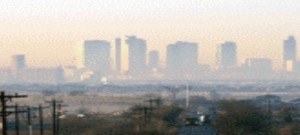 This is why it's important for citizens to have real scientific horsepower.
This is why it's important for citizens to have real scientific horsepower.
DFW has a smog problem. It's not as bad as it used to be, but it's still at unsafe and illegal levels. And for the last four or five years, the air quality progress that should have been made has been stymied. Despite almost all large sources of smog-producing pollution being reduced in volume, our running average for ozone is actually a part per billion higher than it was in 2009.
Many local activists believe this lack of progress is due to the huge volumes of smog-producing air pollution being generated by the thousands of individual natural gas sites throughout the DFW region itself, as well as upwind gas and oil plays. In 2012, a Houston-based think tank released a report showing how a single gas flare or compressor could significantly impact downwind smog levels for up to 5 mile or more. Industry and the Texas Commission on Environmental Quality say no, gas sources are not significant contributors to DFW smog. In fact, during this current round of planning, the state has gone out of its way to downplay the impact of gas pollution, including rolling back previous emission inventories and inventing new ways to estimates emissions from large facilities like compressor stations.
Into this debate steps a UNT graduate student offering a simple and eloquent scientific analysis that uses the state's own data on smog to indict the gas industry for its chronic persistence in DFW – especially in the western part of he Metromess, where Barnett Shale production is concentrated.
On Monday night Denton Record-Chronicle reporter Peggy Heinkel-Wolfe gave a summary of a presentation on local air quality she'd sat through that day at UNT:
"Graduate student Mahdi Ahmadi, working with his advisor, Dr. Kuruvilla John, downloaded the ozone air monitoring data from the Texas Commission on Environmental Quality back to 1997, a total of more than 6.5 million data points, he said, and has been studying it for the past four months.
Ahmadi wanted to explore a basic question underlying a graphic frequently distributed by the TCEQ that shows gas wells going up in DFW as ozone goes down, which suggests in a not-very-scientific-at-all way, that the increasing number of gas wells is having no effect on the ozone.
Ahmadi adjusted for meteorological conditions to determine how much ozone DFW people are making and where. Such adjustments have been explored by others to understand better the parts of ozone-making we can control, because we can’t control the weather. He used an advanced statistical method on the data, called the Kolmogorov-Zurbenko filter, to separate the effects of atmospheric parameters from human activities.
According to the results, the air monitoring sites surrounded by oil and gas production activities, generally on the west side of DFW, show worse long-term trends in ozone reduction than those located farther from wells on the east side of DFW.
His spatial analysis of the data showed that ozone distribution has been disproportionally changed and appears linked to production activities, perhaps an explanation why residents on the western side of DFW are seeing more locally produced ozone, particularly since 2008.
Ahmadi's results are not definitive, and the paper he's writing is still a work-in-progress. But he's asking the right questions, and challenging the right unproven assumptions. He's at least put forth an hypothesis and is trying to prove or disprove it. He's using science. TCEQ's approach is all faith-based.
Anything that takes the focus off vehicle pollution is anathema to Austin and many local officials who want to pretend that industrial sources of air pollution don't impact the DFW region enough to make a difference so they don't have to regulate them. If there's a guiding principle to TCEQ's approach to this new clean air plan, due in July 2015, it's to avoid any excuse for new regulations while Rick Perry is running for President. The agency isn't interested in doing any kind of science that might challenge that perspective – no matter how persuasive. After all, you're talking about a group that doesn't believe smog is bad for you. TCEQ doesn't want to know the truth. It can't handle the truth. It's got an ideology and it's stickin' to it.
So it's up to young lowly graduate students from state universities armed only with a healthy sense of scientific curiosity to step up and start suggesting that the Emperor's computer model has no clothes, and offering up alternative scenarios to explain why DFW air quality is stuck in neutral. It turns out, just doing straight-up classroom science is enough to threaten the fragile House of Computer Cards with which the state's air plan is being built.
Perhaps equally as ominous for the success fo any new clean air plan is Ahmadi's discovery that ozone levels in DFW have been during the winter time, or "off-ozone-season." There could be a new normal, higher background level of smog affecting public health almost year round.
Mahdi Ahmadi's study is just one of the many that need to be done to construct an honest clean air plan for DFW, but it shows you what a curious mind and some computing power can do. Citizens can't trust the state to do the basic science necessary as long as the current cast of characters is running the show in Austin. EPA won't step in and stop the farce as long as TCEQ can make things work out on paper. If the scientific method is going to get used to build a better DFW clean air plan, it's going to have to be citizens who apply it.
Eagle Ford Follow-Up: Your Tax Dollars at Work
 There's not much of a local air planning process left in DFW. What remains is an irregularly-scheduled "technical committee meeting" that mostly involves the staff of Rick Perry's Texas Commission on Environmental Quality explaining how their new anti-smog plan will be successful without the addition of any new pollution controls. But after this explanation any members of the audience can ask questions about the presentation. And if they need to, they can ask follow-up questions. It's the only forum where citizens can do this with a real live TCEQ staffer and the staff is expected to respond. You may not like their response, but there is an exchange.
There's not much of a local air planning process left in DFW. What remains is an irregularly-scheduled "technical committee meeting" that mostly involves the staff of Rick Perry's Texas Commission on Environmental Quality explaining how their new anti-smog plan will be successful without the addition of any new pollution controls. But after this explanation any members of the audience can ask questions about the presentation. And if they need to, they can ask follow-up questions. It's the only forum where citizens can do this with a real live TCEQ staffer and the staff is expected to respond. You may not like their response, but there is an exchange.
The value of a place where citizens can ask questions of TCEQ and expect to get answers rises when one reads about how difficult it was for the reporters working on the huge Eagle Ford expose published last week to get anyone at the TCEQ to answer their questions at all, much less in person. In a sidebar piece that ran with the original piece, titled "How We Got the Eagle Ford Story," they explain the obstacles the state put in their way,
The agency responsible for regulating air emissions—the TCEQ—refused to make any of its commissioners, officials or investigators available for interviews. Instead, we had to submit questions via emails that were routed through agency spokespeople. It's unclear if the spokespeople passed our questions along to the agency’s experts. We received answers to most of our emails, often in some detail. But some of our questions were ignored or answered with talking points on general topics. The TCEQ employees who dealt with our public records requests were helpful and responsive, however. They discussed the filing process over the phone and answered questions about our requests.
*When a reporter called TCEQ field inspectors at their homes—a commonly used reporting technique—TCEQ spokeswoman Andrea Morrow left the reporter a message saying, “Under no circumstances are you to call our people and harass them at home.” Morrow also blocked the reporter from approaching the agency’s chairman, Bryan Shaw, at a public meeting in Austin.
The next DFW anti-smog plan "technical meeting" is 10 am on Thursday April 17th at the North Central Texas Council of Government's headquarters at 616 Six Flags Road in Arlington. One of the biggest controversies with the state's approach is determining the amount of gas and oil industry air pollution that's actually out there affecting DFW. The Eagle Ford story shines a bright spotlight on why the TCEQ really doesn't have a clue about the true amount of gas pollution, so why is it so confident about its numbers in the Barnett Shale, or the shale plays to the south and east of us that are upwind during "ozone season?" Good question. Come ask it on the 17th.
Eagle Ford Expose Reveals Weakness in Gas Air Pollution Inventories and That’s Bad News For DFW
 By now, many of you have seen the massive eight-month act of journalism that the Center for Public Integrity committed in describing the situation in the Eagle Ford shale play in South Texas. It's probably the most comprehensive look at what it's like to live in Texas fracking hell that's been published, and it rightly got distributed far and wide.
By now, many of you have seen the massive eight-month act of journalism that the Center for Public Integrity committed in describing the situation in the Eagle Ford shale play in South Texas. It's probably the most comprehensive look at what it's like to live in Texas fracking hell that's been published, and it rightly got distributed far and wide.
Along with the now-familiar litany of acute human health effects from gas mining – nosebleeds, headaches, skin rashes, respiratory problems – the article also talked about the smog-forming pollution cause by the thousands of small, medium-sized and large gas facilities that invade a shale play. Together they represent a formidable air quality challenge.
Centering on the Buehring family of Karnes City, the piece lists the inventory of gas mining infrastructure surrounding their home. Besides the 50 wells within two and a half miles, they also host,
"….at least nine oil and gas production facilities. Little is known about six of the facilities, because they don't have to file their emissions data with the state. Air permits or the remaining three sites show they house 25 compressor engines, 10 heater treaters, 6 flares, 4 glycol dehydrators and 65 storage tanks for oil, wastewater and condensate. Combined, those sites have the state's permission to release 189 tons of volatile organic compounds, a class of toxic chemicals that includes benzene and formaldehyde, into the air each year. That's about 12 percent more than Valero's Houston Oil Refinery disgorged in 2012.
Those three facilities also are allowed to release 142 tons of nitrogen oxides, 95 tons of carbon monoxide, 19 tons of sulfur dioxide, 8 tons of particulate matter and 0.31 tons of hydrogen sulfide per year. Sometimes the emissions soar high into the sky and are carried by the wind until they drop to the ground miles away. Sometimes they blow straight toward the Buehrings' or their neighbors' homes.
That's 331 tons a year of smog-forming Nitrogen Oxides and Volatile Organic Compounds released from just a small number of square miles in the Eagle Ford. Just two more collections of facilities like that would equal all the smog pollution coming from the TXI cement plan tin Midlothian – North Texas' single largest smog polluter. It's no wonder then that a San Antonio Council of Governments air pollution model found that Eagle Ford smog pollution would make it impossible for the Alamo City to comply with the new 75 parts per million federal ozone standard.
Moreover, that 331 tons a year figure is just what can be discerned by reading Texas' archaic permitting records. The Center's reporters do a real public service in identifying the loopholes and gaps the system encourages that hide the true air pollution numbers,
Texas' regulatory efforts are also hamstrung by a law that allows thousands of oil and gas facilities—including wells, storage tanks and compressor stations—to operate on an honor system, without reporting their emissions to the state.
Operators can take advantage of this privilege—called a permit by rule, or PBR—if their facilities emit no more than 25 tons of VOCs per year and handle natural gas that is low in hydrogen sulfide. Two employees in the TCEQ's air permits office—Anne Inman and John Gott—estimate these PBRs could account for at least half of the hundreds of thousands of air permits the agency has issued for new or modified oil and gas facilities since the 1970s.
Operators with this type of permit aren't required to file paperwork backing up their self-determined status, so the TCEQ has no record of most of the facilities' locations or emissions. A chart generated in 2011 by the office of then-TCEQ executive director Zak Covar says the permits "Cannot be proven to be protective. Unclear requirements for records to demonstrate compliance with rules."
Big operators sometimes get a PBR for each component of a facility. Each might be under the 25-ton-per-year threshold that would require a more rigorous permit, but the facility as a whole could emit more than that.
The TCEQ refers to the practice as the "stacking of multiple authorizations," and the memo from Covar's office said its use "means that protectiveness and compliance with the rules cannot be demonstrated."
But of course that doesn't keep Rick Perry's TCEQ from saying everything is all right. As per usual, officials want to the results of stationary monitors in the region to assure residents that nothing unhealthy is being breathed-in.
"[M]onitoring data provides evidence that overall, shale-play activity does not significantly impact air quality or pose a threat to human health," agency spokeswoman Andrea Morrow wrote in an email."
But in this case, the region, covering a huge area from East Texas to the Rio Grande, has only five such monitors, "all positioned far from the most heavily drilled areas."
Moreover, that's just the holes in the permitting process itself. What about when a facility is a bad actor and has an "emission event' or "upset" where more than the permitted amount of pollution is released for hours or even days at a time?
"The number of emission events associated with oil and gas development doubled between fiscal years 2009 and 2013, from 1,012 to 2,023. The amount of air pollutants released into the Texas air during these events increased 39 percent."
A gas processing plant in McMullen County, in the southwestern portion of the Eagle Ford, reported 166 emission events last year, almost one every other day. From 2007 through 2011, the Tilden plant, owned by Regency Energy Partners of Dallas, discharged 1,348 tons of sulfur dioxide during such episodes. That's more than 30 times the amount it was legally allowed to release during "normal" operations.
Marathon waited three months to report a 2012 incident at its Sugarhorn plant near the Cernys and Buehrings. It released 26,000 pounds of VOCs in 12 hours, 1,000 times more than allowed under its air permit.
But what has this got to do with DFW smog? Everything. Besides the Barnett Shale play entering and enveloping the Metromess from the West, we also have the Eagle Ford and Haynesville shale plays to our South and East – upwind of DFW during our eight-month "ozone season." There are now as many wells in close proximity to DFW up wind as downwind.
Right now, as part of the new anti-smog plan for DFW being drafted by the TCEQ, the state is "re-calculating" oil and gas air pollution emissions and you'll never guess how that's working out – TCEQ is using industry advice to lower their estimates from last time around. At a January 31st meeting of what's left of the local air planning process, the state presented its new study that it's using to revise the considerable amount of air pollution coming from leaks and releases from condensate storage tanks in the Barnett and elsewhere. As of 2012, these releases are estimated by TCEQ to be only 25% of what they were in 2006. See how well that works out? And this number will be plugged into the computer model that then estimates how much of that air pollution turns into smog.
Instead of getting real world numbers for compressor stations, the TCEQ is now using a fomula based on local production and horsepower to estimate emissions, and guess which way this new technique is sending the numbers?
TCEQ is doing everything it can to make sure that the oil and gas air pollution numbers are as low for this new anti-smog plan as they can make them without breaking out laughing. Why? To prevent the call for new controls on these sources, even though everyone knows they're adding to the problem. Oil and gas emissions are the one air pollution category in DFW that's grown in volume since 2006, while others, like the Midlothian cement plants and East Texas coal plants, and even cars, have all gone down. Meanwhile, DFW ozone averages are higher then they were in 2009. Many of us don't think that's a coincidence. But the ideologically-driven TCEQ can't afford to admit the obvious – not while Rick Perry is running for President.
Compare the TCEQ strategy in DFW with the reality described in the Center for Public Integrity's reports from the Eagle Ford Shale and you have two completely different pictures of the amount of air pollution coming from the oil and gas industry. Which do your trust more – the official calculations coming out of Austin, or the secret memos and field reports uncovered by the reporters?
If what's happening in South Texas is also what's happening in the shale plays in and around DFW – and there's no reason to think it isn't – then the volumes the TCEQ is plugging into its anti-smog plan for the Metromess are off by large factors. That in turn could spell doom for the plan, due to be submitted to the EPA by July of 2015 – a little over a year from now.
This is why it's important for citizens to have their own computing power with their own modeling capabilities. It's the only way to call TCEQ's bluff that it's using all the right information to draft its new clean air plan to EPA. Without the technical know how to be able to look over TCEQ's shoulders and reveal its "GIGO"strategy, our lungs are hostages of Rick Perry's political ambitions.
The next North Texas appearance by TCEQ staff to explain how its estimating – or not – the air pollution from oil and gas industry sources as well as every other source – is scheduled for 10 am on Thursday, April 17th at the HQ of the North Central Texas Council of Governments located at 616 Six Flags Drive – right across the street from the Amusement Park. We need citizens to come out and ask pointed questions about the TCEQ effort to keep us from being taken on another ride to nowhere. Anyone can come and ask questions of the presenters – it's an open forum – and indeed it's the ONLY opportunity citizens have to actually quiz the TCEQ about the process. Please mark the date and try to be there. Meetings usually last until 12 noon or so. They think you're not paying attention. These numbers and quotes from the Public Integrity Center piece gives you lots of ammunition to prove otherwise.
Between Now and Friday: Tell Them What They Can Do With Their Smog
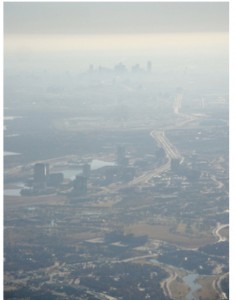 Frustrated that Rick Perry's Texas Commission on Environmental Quality isn't doing enough to end DFW's chronic smog problem, the local "Council Of Governments" has issued a "Request for Information" asking for the public's help in suggesting ways to reduce ozone pollution in North Texas.
Frustrated that Rick Perry's Texas Commission on Environmental Quality isn't doing enough to end DFW's chronic smog problem, the local "Council Of Governments" has issued a "Request for Information" asking for the public's help in suggesting ways to reduce ozone pollution in North Texas.
Please use our Click N' Send E-mail form to make sure they get the message that the public wants:
1) State-of-the-Art pollution controls on huge "point sources" of pollution like the Midlothian cement kilns and East Texas power plants.
2) New pollution control equipment and strategies to reduce the air pollution from the thousands of natural gas facilities mining the Barnett Shale.
3) Inclusion of all trucks and off-road vehicles in the state's vehicle maintenance and inspection program.
You can also add strategies or ideas of your own as well. Just click here, fill out the e-mail and send it in to be counted.
It takes as little as 30 seconds.
BUT YOU ONLY HAVE UNTIL 5 pm FRIDAY, VALENTINE'S DAY.
______________________________________________________________
Rick Perry's TCEQ is so discredited on the matter of DFW smog, local officials usually working in concert with the state agency are now looking elsewhere for help.
Ever since DFW was required to write and submit new clean air plans, The North Central Texas Council of Governments has been the local vehicle used by the state to funnel information, concern, and ideas back and forth.
It was never easy to get Austin's attention or convince the Powers That Be of the need to take bigger clean air measures. It took a decade for Downwinders to get the State to admit that the Midlothian cement plants had a huge impact on local air quality before they were the targets of new controls.
But ever since Rick Perry began running for President in 2010, it's been impossible for Austin toget serious about any DFW clean air plan. For the past four years, TCEQ has claimed that it can reduce air pollution enough by doing nothing.
That strategy has been a dismal failure. New car buying in the middle of the worst economic downturn since the 1930's was the TCEQ clean air plan in 2011. Austin promised that if we just sat back, we'd have the lowest smog levels ever recorded. Instead we had worse air pollution levels than we did five years ago.
This time round, TCEQ is saying a new EPA-mandated low-sulfur gasoline mix in 2017 will be the region's savior for the new clean air plan that's supposed to be successful in reaching the new federal ozone standard of 75 parts per billion in 2018. We're at 87 ppm now – still in violation of the old 1997 standard.
Just watch this new fuel being added to cars and see the ozone numbers drop, TCEQ is saying. No need to put controls on gas facilities, or cement kilns, or power plants. Nothing that would give Rick Perry's opponents on the Right any opportunity to claim he was "anti-bidness."
Even the Council of Governments isn't buying it.
That's why, in their own bureaucratic fashion, this Request for Information that the COG has issued is it's own middle-of-the-road middle finger to TCEQ.
Usually, it would be the state facilitating a discussion of new air pollution control strategies, but since it's obviously not interested, the COG has decided to go its own way. That's how bad things have gotten in Austin – even their most reliable allies in DFW can no longer take them seriously.
It's not clear what will happen to the list of control measures that the Council of Governments is assembling. Some might receive some more official attention, but locals have no authority to write or override Austin's decisions. TCEQ is the only entity that's authorized to submit a new clean air plan to EPA by the June 2015 deadline.
But there are ways to use the useless clean air plans that Austin is submitting. Downwinders' own green cement campaign is a great example.
In 2007, we successfully inserted a voluntary air pollution control strategy into the TCEQ plan revolving around the purchasing of cement from newer cleaner "dry" kilns by local North Texas governments. We then took that "green cement" procurement option and went to Dallas to pass the nation's first green cement ordinance. Then Fort Worth passed it. Then Plano. Then Arlington. Then Denton. Then Dallas County. Then Tarrant County.
Within two years, we had established a de facto moratorium on dirtier "wet kiln" cement within at least a dozen municipal and counties. Combined with federal rule changes, we were able to get all Midlothian wet kilns closed. The last one is being be converted to a dry kiln this year. All while Rick Perry was governor.
The same thing could happen with a good "off-sets" policy for gas facilities if a local city of county could pass a template ordinance showing the way. Currently, most of the gas industry is exempt from being required to "off-set" their air pollution in smoggy "non-attainment" areas like other large industries in DFW. Take away this exemption and you'll see a swift decrease in gas industry air pollution.
It's these kinds of strategies that don't depend on action from Austin that offer the greatest potential for progress this time around.
TCEQ has never written a successful clean air plan for North Texas, and it's not going to start now. But citizens themselves can take their lungs' fate into their own hands and begin to build a system of local measures that can make breathing easier.
______________________________________________________________
CALENDAR AND STATUS REPORT OF DFW'S NEWEST CLEAN AIR PLAN
Reach a 3-year rolling average of no more than 75 ppm of ozone at all 18 DFW area air monitors.
The New Gas Pollution Problem for DFW in Two Pictures
 So far the debate over how much impact the gas industry has had on DFW air quality has centered on the Barnett Shale. That's logical because that's the gas play right in front of us, in the middle of the North Texas "non-attainment area" for smog. One of the main arguments Rick Perry's Texas Commission on Environmental Quality has made against any significant impact is that most of the drilling is happening west of the DFW urban centers.
So far the debate over how much impact the gas industry has had on DFW air quality has centered on the Barnett Shale. That's logical because that's the gas play right in front of us, in the middle of the North Texas "non-attainment area" for smog. One of the main arguments Rick Perry's Texas Commission on Environmental Quality has made against any significant impact is that most of the drilling is happening west of the DFW urban centers.
Ignoring how geographically-incorrect this argument is – there's drilling and compressors in Dallas County right now, much less Ellis, Johnson. Denton and Tarrant – let's just cede the argument to the state that it would take gas fields to the Southeast of us, that is, upwind of us during ozone season, to really impact our air quality.
Guess what? There's gas fields Southeast of DFW that are producing lots of air pollution.
In previous posts over at least the last two years, we've shown that if you add up the standard permits of all the gas compressors in Freestone County alone, they represent more smog pollution than the Big Brown Coal Plant doing business down the road. Now there's new evidence of the size of these gas fields and their relationship to the DFW airshed, thanks to Google.
Here's a picture of the area we're talking about – just about an hour and a half drive southeast of DFW, east of Waco. That makes it directly upwind during ozone seasons.
When you zoom into where the green arrow is, you see the familiar sight of hundreds of square drilling pads laid out over the landscape – just like the Barnett Shale – only DFW is directly downwind of it during the summer.
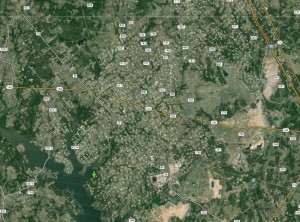 Pollution from these sources has most likely been grossly underestimated by the state. Moreover, when gas field pollution comes into an urban area with dirty air, it increases the likelihood of that pollution turning into smog. Rick Perry's employees are loath to admit the gas industry plays any part in the stagnation of DFW air quality progress since 2007, but as these images make clear, facts on the ground trump their ideology.
Pollution from these sources has most likely been grossly underestimated by the state. Moreover, when gas field pollution comes into an urban area with dirty air, it increases the likelihood of that pollution turning into smog. Rick Perry's employees are loath to admit the gas industry plays any part in the stagnation of DFW air quality progress since 2007, but as these images make clear, facts on the ground trump their ideology.

